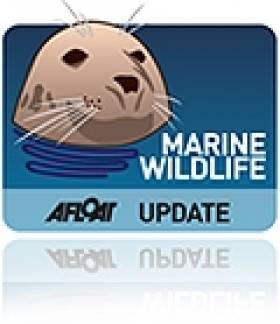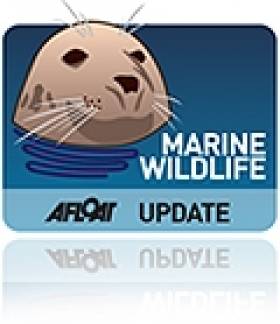Displaying items by tag: cetacean
Stranded 'Whale' Perishes In Tralee Bay Shallows
#MarineWildlife - The Irish Examiner reports that a six-metre cetacean that prompted a mass rescue effort when it beached in Ballyheigue in Co Kerry earlier this week has died in the shallows.
The marine mammal, as yet unidentified but thought to be a large dolphin or small whale, drew crowds to the beach on Tralee Bay when it stranded in low water on Monday evening, according to Independent.ie.
Locals joined Ballyheigue Inshore Rescue in an attempt to haul the animal out to deeper water, with as many as 20 people involved in the operation.
But their efforts were for naught when the cetacean refused to swim out into the bay and was later seen thrashing its tail in the shallows.
It was hoped that the animal would eventually swim out with the tide, but was reported dead yesterday.
Samples are due to be taken by the Irish Whale and Dolphin Group to determine its species and condition.
The Irish Examiner has more on the story HERE.
Humpback Surprises West Cork Over St Patrick's Weekend
#MarineWildlife - A juvenile humpback whale sighting off West Cork provided a St Patrick's weekend surprise for cetacean watchers.
Irish Whale and Dolphin Group (IWDG) sightings co-ordinator Pádraig Whooley writes on the discovery made off the Stags on the afternoon of Monday 18 March, which was verified by IWDG members Simon Duggan, Youen Yacob and Robbie Murphy.
Photo ID images captured at the scene allowed experts to confirm the whale is a newcomer to Irish waters, bringing the known total to 22 and continuing a growing trend.
Whooley also notes the unusual nature of the sighting, coming some months after the busy humpback whale activity in the area previously reported on Afloat.ie.
Those whales weren't seen again after that flurry of breaching and bubble-netting off Baltimore - presumably because being an older group, they were drawn south by their migratory instinct to the tropical feeding grounds.
In contrast, this likely juvenile - named Baltimore - may have opted to winter in higher latitudes to avoid competition with bigger counterparts, something that a group of humpbacks in the Norwegian fjords have also chosen to do this year.
The IWDG has more on the story HERE.
Mystery of Missing 'Narwhal' in Clare is Solved
#MARINE WILDLIFE - The mystery disappearance of an allegedly rare whale carcass from a Co Clare beach last week has been solved.
As The Irish Times reports, Clare County Council admitted yesterday that the "badly decomposed whale" was removed from Liscannor beach "due to public health concerns".
The vanishing of the creature had been a source of puzzlement to the Irish Whale and Dolphin Group (IWDG), after scientists dispatched to examine the carcass found no trace on arrival.
Experts had been hoping to verify whether the carcass was indeed that of a narwhal, an Arctic cetacean renowned for its unicorn-like tusk.It would have been the first recorded sighting of a narwhal in Irish waters.
Max Halliday from Shannon, who reported the find to the IWDG, said he was "convinced that what I saw is a narwhal. It had the long tusk protruding from its head, but its head was badly damaged. I am absolutely mad that I didn't take a photo."
According to the Irish Independent, the IWDG had appealed to those responsible for removing the whale to get in touch so the remains could be transferred to the Natural History Museum.
But it has since emerged that the creature was taken to a rendering plant in Derry by a team contracted by the council.
A spokesperson for Clare County Council said no remains of a tusk were found in the removal operation.
Fin Whales Could Be Wexford Bound
#MARINE WILDLIFE - The Enniscorthy Guardian reports that the fin whales that have been sighted off Tramore in recent weeks may soon make their way towards the Wexford coast.
Afloat.ie recently reported that Waterford was the 'best place to be' for whale watching, with the Irish Whale and Dolphin Group (IWDG) confirming fin whale sightings along a 20-mile stretch from Stradbally to Brownstone Head.
Cetacean fans are being advised to keep an eye on the coast from Hook Head to Brownstown headland to catch a glimpse of the fins, which are renowned for their six-foot whale blow.
Whale watchers are also urged to report any sightings to the IWDG online at www.iwdg.ie to help keep its database up to date.
First Sighting of a Dolphin in an Irish Lake
#MARINE WILDLIFE - The first recorded sighting of a dolphin in an Irish lake has been reported by the Irish Whale and Dolphin Group (IWDG), according to The Irish Times.
The dolphin was spotted in Lough Hyne, a saltwater lake near Baltimore in Co Cork by Skibbereen-based kayaking instructor Jim Kennedy, who filmed it over a number of days.
"To the best of my knowledge, and I’m open to correction, this is the first validated record of a cetacean using an Irish lake," said the IWDG's Pádraig Whooley.
Though there have been no further sightings since then, there is nothing to indicate that the dolphin has yet left the lough for the open sea.
As previously reported on Afloat.ie, Lough Hyne was also recently visited by a 13-metre fin whale that was sadly found beached in stormy conditions on the Sligo coast this week.
The Irish Times has more on the story HERE.
































































